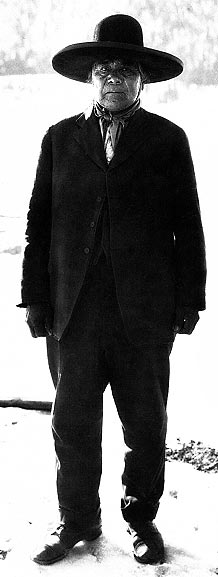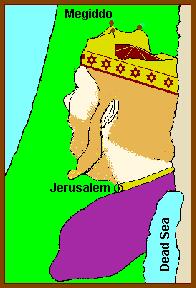
Discovery of King Tut's Tomb
|
Discovery of King Tut's
Tomb
AT LAST HAVE MADE WONDERFUL DISCOVERY IN VALLEY; A MAGNIFICENT TOMB WITH
SEALS INTACT; RECOVERED SAME FOR YOUR ARRIVAL; CONGRATULATIONS
This telegram, sent by Howard Carter to his sponsor, Lord Carnarvon, on November
6, 1922, electrified the world. Searching amid rubble heaps left by dozens
of archaeologists over a span of a hundred years, Carter had finally tried
one last desperate dig. His area: a small triangle of rocky debris bounded
by the tombs of Ramses II, Merneptah, and Ramses VI. Almost by chance, his
native laborers cleared away three feet of earth beneath an innocuous
workman’s hut erected centuries before, and found the first of sixteen
steps cut steeply down into the bedrock. The hidden entry led to a blocked-up,
sealed door bearing the special mark that identified the tomb as a royal
necropolis. With admirable restraint, Carter went no further. Filling the
stairway with rubble again, to prevent looting, he posted a guard and awaited
Carnarvon’s arrival three weeks later.
On November 25, with Carnarvon present, Carter pulled down the sealed door.
Beyond it he found another rubble-filled passageway thirty feet long and
a second sealed door. Again the barricade was torn away -- to reveal a sight
that rendered him speechless. By the flickering light of his candle, he saw
strangely shaped animal figures and statues and a jumbled mass of objects
-- all glinting of gold. As his eyes became accustomed to the dim light,
gilded couches, gold-plated chariots, and hundreds of other spectacular
treasures, strewn haphazardly about the chamber, appeared. They had found
the burial place of the boy-king Tutankhamen.
The news went out immediately. For two months, Carter’s team photographed,
catalogued, and packed the items for shipment to Cairo. With great care,
Carter treated the 32-centuries-old objects to preserve them against further
decay, as the press reported his every move from tents hastily pitched at
the site.
On February 17, with the antechamber now cleared, Carter and Carnarvon broke
through into the next sealed room, the burial chamber itself. The sight was
unbelievable. the entire room -- except for a fifteen-inch space at each
side -- was filled by a huge golden shrine ten feet nine inches wide, sixteen
feet six inches long, and nine feet high. Carter opened the folding (but
not sealed) doors at the shrine’s east end. A second set of doors confronted
him, these bolted and sealed. At last Carter’s search had reached the
ultimate, a point beyond which grave robbers had not been able to penetrate.
An undefiled mummy still lay concealed within the shrine.
Lord Carnarvon did not live to marvel at what was to come next; he died just
two months later, in 1923, from an insect bite. Despite a series of delays
imposed by the Egyptian government, Carter continued the discoveries through
the winter seasons of 1925-27. The tremendous shrine proved to be actually
four shrines, one inside the other, Chinese box-fashion. And inside the innermost
was the sarcophagus, a large, yellow quartzite block with a rose granite
lid that weighed well over a half ton.
The climax was yet to come. Before the sarcophagus lid could be raised, the
shrine had to be taken apart and removed from the room. Its transfer from
the burial chamber took 84 days of struggle -- almost a full day for each
of its component parts, all of them heavy, hard to handle, and very fragile.
Ironically, Carter discovered that while the artisan craftsmanship used to
build the shrine had been superb, the assembly laborers had left a good deal
to be desired. Ignoring the markings that indicated the proper assembly sequence,
the workers had put the shrine together backward, with the doors facing east
instead of west and the side panels reversed. And they had pounded reluctant
joinings into position with heavy hammer blows, leaving noticeable dents.
The opening of the sarcophagus gave the final surprise. An outer anthropoid
coffin concealed a second, and the second a third. The innermost coffin was
the most amazing find of all: a solid gold case six feet one and three-quarters
inches long and nearly one-quarter inch thick, worth a princely sum. Within
the final coffin lay the goal of the dig -- the mummy of King Tut. On Tut’s
face was a 22-pound solid gold burial mask. Carter soon learned that the
king’s embalmers had erred in seeking to preserve the corpse for the
ages. They had poured a tarlike unguent between the gold coffin and the wooden
(middle) coffin as well as over the wrapped mummy. During the centuries a
chemical reaction had carbonized the bones and tissues beyond any hope of
salvage.
The mummy’s bindings hid 143 pieces of jewelry, which joined the treasures
already found. Eventually a total of 5,220 items were catalogued. Tut’s
body was returned to the tomb where it rests today. The valuable treasures,
however, are on display at the Cairo Museum. On rare occasions the Egyptian
authorities permit exhibitions of them outside the country.
King Tut himself was probably insignificant, dying around 1323
BCE at the age of about nineteen. But the riches found
in his tomb gave the world its first glimpse of a complete funerary assemblage
for an Egyptian pharaoh, objects previously described in religious texts
and contemporary writings.
Opening the tomb gave rise to a press-inspired "pharaoh’s curse." Carnarvon
had died almost immediately, and allegedly a score of other individuals were
struck down because of their involvement with dismantling the shrine. Of
the ten principal diggers at Tutankhamen’s tomb, two were alive forty
years later, and another five lived an average of twenty years beyond its
opening.
However, the tomb itself was the victim of a curse -- tourists. By 1991,
3,000 visitors a day were entering the tomb and stirring up the dust on the
walls. Their sweat released salt that clung to the walls, and their breath
released organisms that remained trapped inside the tomb. The tourists brought
with them bacteria and fungi that damaged the contents of the tomb, leading
the Egyptian Antiquities Organization to declare the area closed.
[From: The 20th Century by David Wallechinsky]
More Reading
The
Complete Tutankhamun
by C.N. Reeves
The
Discovery of the Tomb of King Tutankhamen
by Howard Carter
The
Curse of Tutankhamen
by Elaine Landau
The
Murder of Tutankhamen: A True Story
by Bob Brier
Encyclopedia
of Mummies
by Bob Brier
Ancient
Egyptian Magic: Spells,
Incantations, Potions, Stories, and Rituals
by Bob Brier
Egyptian
Mummies: Unraveling
the Secrets of an Ancient Art
by Bob Brier
Cgronicle
of the Pharaoahs
by Peter A. Clayton
The
Complete Pyramids
by Mark Lehner
The
Complete Valley of the Kings
by C.N. Reeves et al
Ancient
Egypt
by David P. Silverman
Mummy
in Ancient Egypt:
Equipping the Dead for Eternity
by Salima Ikram and Aidan Dodson
Temples
of Ancient Egypt
by Dieter Arnold et al
Mummy
Rummy (Card Game)

|

























